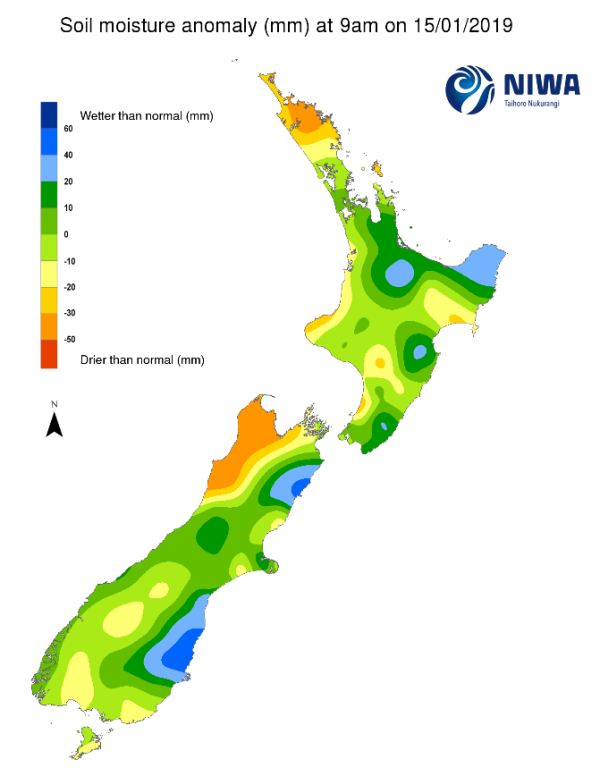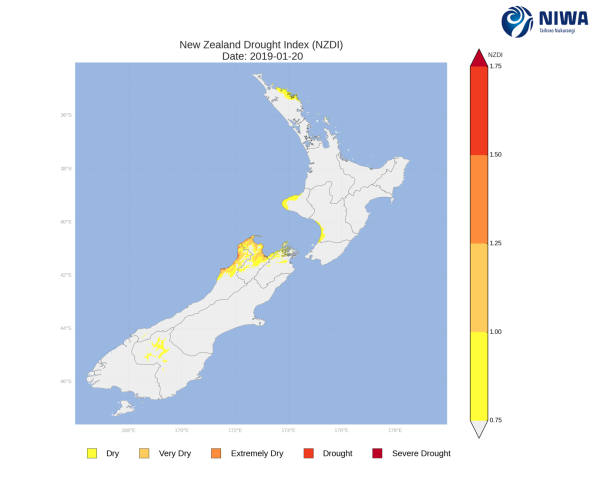A weekly update describing soil moisture across the country to help assess whether severely to extremely dry conditions are occurring or imminent. Regions experiencing these soil moisture deficits are deemed “hotspots”. Persistent hotspot regions have the potential to develop into drought.
Facts: Soil Moisture
Across the North Island, soil moisture levels generally decreased in the west, north and south during the past week, while soil moisture increases were observed around the Central Plateau eastbound to Gisborne and Hawke’s Bay. The driest soils across the North Island compared to normal for this time of the year are found in parts of Northland, costal Waikato and around New Plymouth, while the wettest soils for this time of the year are located in East Cape and a portion of Hastings.
The previous hotspot in the Far North dissipated around the Aupouri Peninsula in the past week, but has spread south into northern Whangarei and Kaipara districts. Another small hotspot developed in coastal Waikato, west of Hamilton.
Across the South Island, soil moisture levels generally decreased slightly in the past week, although small soil moisture improvements were observed in coastal Fiordland, lower coastal West Coast, around Invercargill and Stewart Island. The driest soils across the South Island compared to normal for this time of the year are found in northwestern Tasman, while the wettest soils for this time of the year are found near Kaikoura and north coastal Otago.
The previous hotspot across Nelson remains to the east of Nelson city and in nearby portions of Tasman.
Outlook and Soil Moisture
In the North Island, a weakening front is forecast to bring showers to the south starting Wednesday evening (23rd January), spreading north on Thursday (24th January). Rain totals should generally stay below 10 mm, although rainfall may be higher in the interior ranges. Showers may linger in eastern areas on Friday and Saturday (25-26th January); however, elsewhere in the North Island little if any rainfall will be observed. A weak front may produce a few showers for southwestern areas on Sunday (27th January). High pressure in the Tasman Sea is expected to bring a warm and mostly dry start to next week, but an onshore flow may bring isolated light showers to the west.
Total rainfall over the next seven days will likely stay below normal for this time of year across the North Island with the driest anomalies anticipated in the Far North. Due to the meagre rainfall combined with the warm temperatures next week, soil moisture levels are expected to decrease across the island. The current hotspots will likely strengthen and expand in the upcoming week.
For the South Island, a southerly change will bring heavy rain to the West Coast and showers to the south and east today (23rd January). Total rain amounts in the central West Coast may exceed 50 mm. Another front will reach the West Coast and the far south on Saturday (26th January) with an additional round of moderate rain west of the divide possible through Monday (28th January).
Total rainfall over the next seven days is expected to stay below normal for this time of year in the east and far north while the west and south will see rainfall amounts above normal. Due to the expected rainfall, soil moisture levels will likely increase in the West Coast, slightly increase or remain constant in the far south, and decrease elsewhere. Thus, the current hotspot in Tasman could strengthen in the next week, while central Canterbury may see a new hotspot form in the coming week.
Background:
Hotspot Watch a weekly advisory service for New Zealand media. It provides soil moisture and precipitation measurements around the country to help assess whether extremely dry conditions are imminent.
Soil moisture deficit: the amount of water needed to bring the soil moisture content back to field capacity, which is the maximum amount of water the soil can hold.
Soil moisture anomaly: the difference between the historical normal soil moisture deficit (or surplus) for a given time of year and actual soil moisture deficits.
Definitions: “Extremely” and “severely” dry soils are based on a combination of the current soil moisture status and the difference from normal soil moisture (see soil moisture maps for more information)



